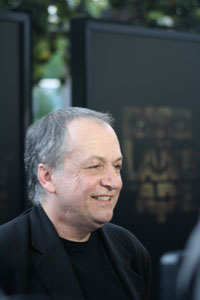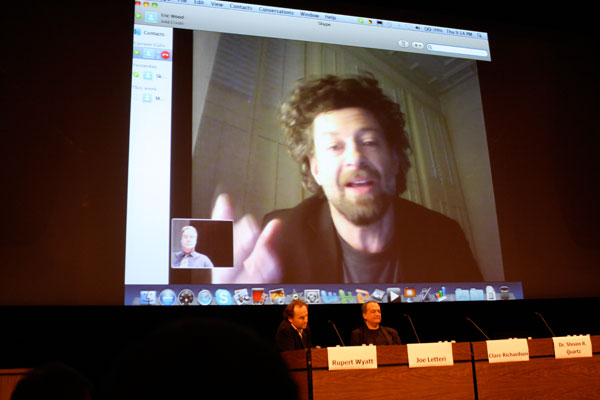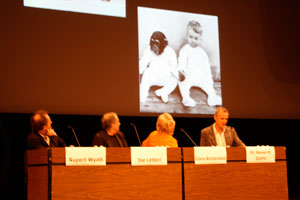Cal Tech- Rise of the Planet of the Apes
 |
Los Angeles Review News was on the scene at Cal Tech Pasadena to meet director Rupert Wyatt, WETA Special Effects Guru Joe Letteri, Actor Andy Serkis, and academics Clare Richardson and Dr. Steven R Quartz. Everything you wanted to know about this film will be answered, including information about the technology that will change the motion picture industry forever. How far is fact from science fiction? Will science create talking apes and if so what would an ape say to you? We will separate the fact from fiction and give an insight on the groundbreaking technology used in the making of the film. |
Rupert Wyatt Explains the Challenge in Directing the Film
In the original Planet of the Apes the actors had a very difficult time emoting the scenes due to limitations in the technology. Although the creative make up designs were far ahead of its time thanks to work of John Chambers, the actors faced a challenge of being able to portray the scenes convincingly using their face. Rupert explains,” My job is to make the movie plausible; we could not use the methods of the past nor could we use live apes. It would actually be very ironic to tell a story of apes rebelling against man if they were working on this film! Also apes have never really been digitally rendered properly. I turned to WETA Digital, specifically Joe Letteri, to see if we could do it. Joe studied actual apes and decided to combine some of the breakthroughs in technology with the performance from an actor.
 | Director Rupert Wyatt being interviewed at Cal Tech Pasadena before speaking on a panel. |
Joe Letteri Discusses a New Direction
 |
While working with James Cameron on Avatar, Joe used a technique of having the actor play out a scene with painted green dots applied to a computer that would show every movement made by the performer. On the advice of Cameron, Joe put a camera mounted a couple of feet from the actor’s face. “ The ideas used in Avatar made the techniques used in Rise of the Planet of the Apes possible. What we have accomplished is to physically put an actor in place of an ape using every nuance, emotion, and facial expression the performer can give us. Once we capture the performance- the emotion- we can put the layers of the ape over the actor using very sophisticated technology.” States Joe. Because the actor has such an important role in the success of the special effect, they turned to actor Andy Sarkis.
Soul of the Actor’s Performance Saves the Day
 |
Andy Serkis is the life of the movie giving the protagonist Caesar his personality. According to Rupert,” We needed an actor who could play out the scene. We called on the Charlie Chaplin of our time Andy Serkis.” The importance of Andy’s performance was not just important for WETA to create a CGI performance for the apes but was equally important for the actors to play off a real performance from another actor. Andy has lent his performance for many memorable characters including Gollum from Lord of the Rings and King Kong. Andy says, “ It is so incredible being able to just act without blank plates, rotoscoping, green screen, and all the other limitations. Also is nice to act within the scene with the actors.” This technology will change how people will think of computer generated images now that real performers can portray anything. Andy studied apes with Clare Richardson at the Dian Fossey Gorilla Fund International.
Monkey See Monkey Do
 |
Some of the common misconceptions of apes are that they are violent. One of the most important lessons that Clare Richardson was able to teach actor Andy Sarkis is that humans are the most violent primate on the planet. This changed the dynamic of the performance; giving Andy the freedom to let his character, Caesar, become human and then turn violent. Clare says, “Apes do not destroy their environment, they eat fruits and vegetables, they will let you observe them. In order for the film to be believable, the apes would have to mimick human behavior. I hope people don’t watch this movie thinking apes are violent. Part of the work we do at Dian Fossey Gorrila Fund International is to educate people away from the Hollywood “King Kong” myth of an aggressive, savage beast.”
Turning Science Fiction Into Science Fact
 |
The brain of a human is different in the pre-natal stage from an ape, however, scientific research has been done to see if an ape raised like a human can develop. According to Dr. Steven R Quartz of Cal Tech, “ Humans pass the intelligence of apes at about 4 years old but apes have an amazing memory. In many tests of memory using numeric placeholders on a computer monitor, apes consistently were able to place the holders in the same position better than their human counterparts. Using the Theory of the Mind, apes are masters at mimicking and look for visual cues. If an ape was to be genetically altered it would change how he would act in the environment. He would probably develop the taste for IN-And-Out Burgers!”
 |
Tying in the original mythology If you are a fan of the original movies or just feel like going ape- see the Rise of the Planet of the Apes. The film is coming to you on August 5th |